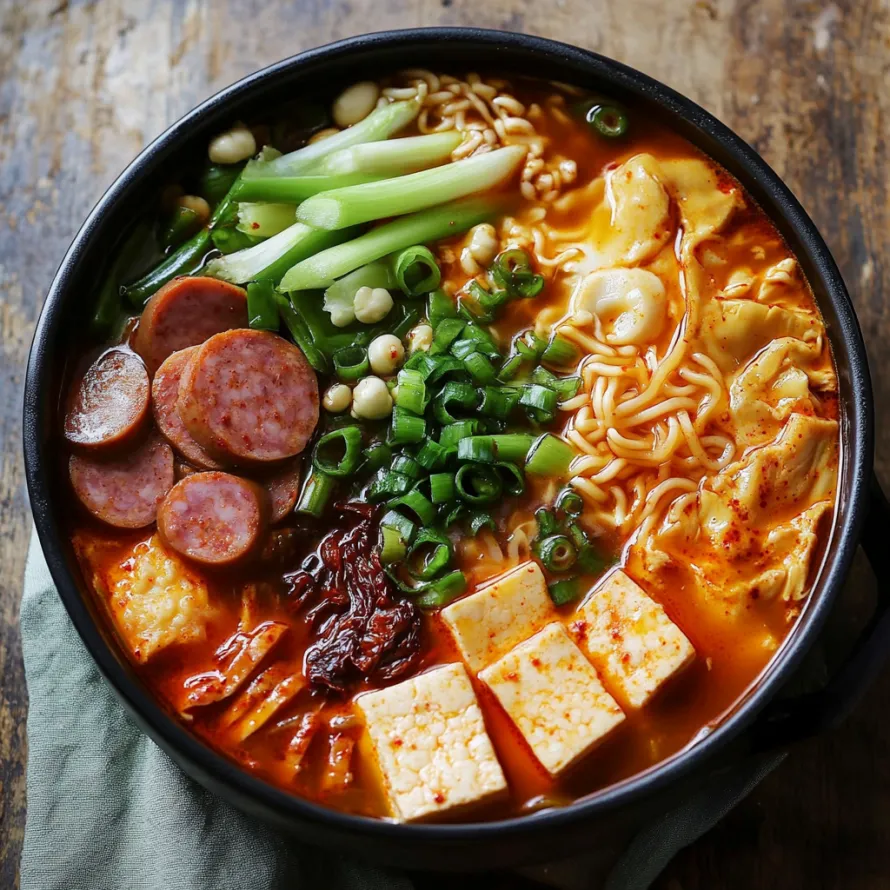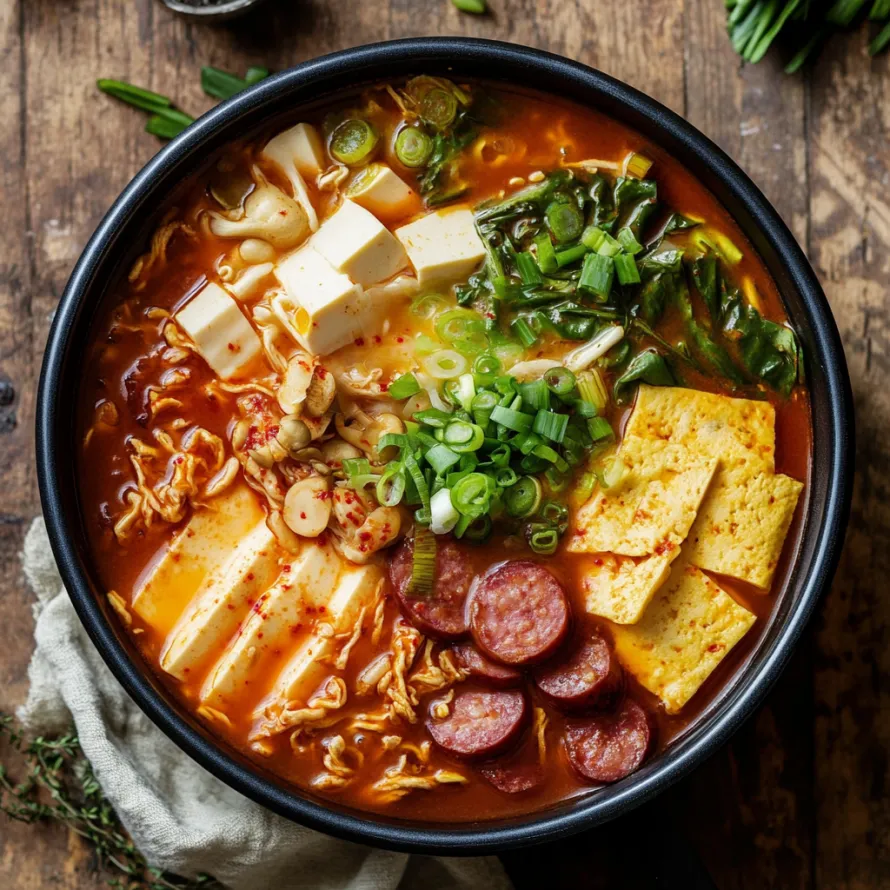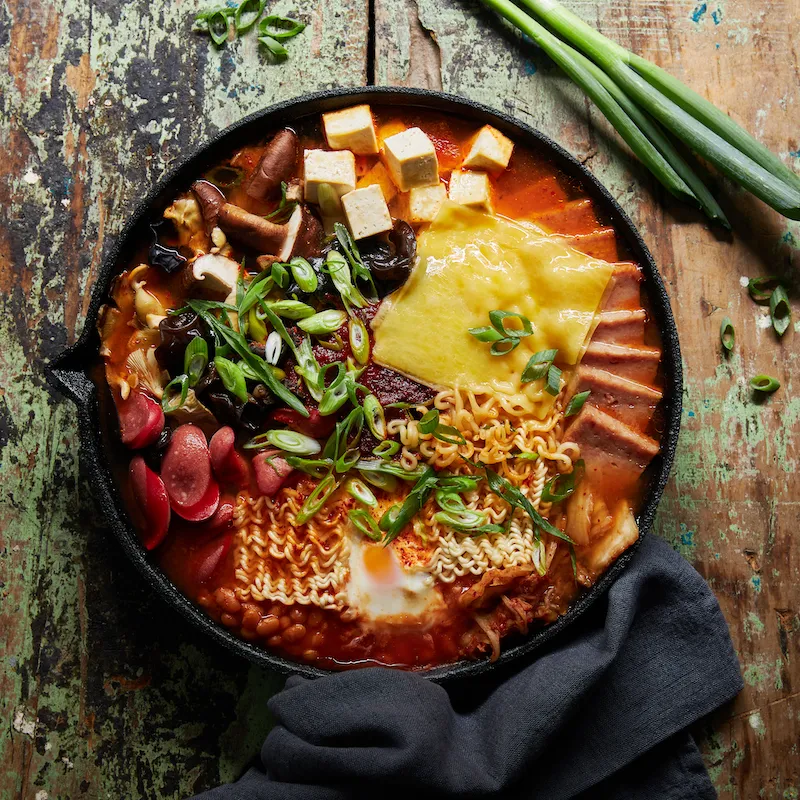 Pin it
Pin it
This colorful Budae Jjigae combines unexpected ingredients into a delightful mix that tells the story of cross-cultural food history. Every mouthful offers multiple taste sensations—the kick of gochugaru, the sour notes of fermented kimchi, the umami from processed meats, and the gooey goodness of cheese swimming on a spicy broth. What makes this shared meal special is how the clashing textures and strong tastes somehow fit together perfectly, making a truly filling dish that gets everyone huddled around the steaming pot to enjoy its welcoming heat together.
I stumbled upon Budae Jjigae on a cold winter night at a tiny Seoul eatery, where they brought the furiously boiling pot to our table. The place's owner told us how this dish came from post-war improvisation, when Korean cooks cleverly used American military leftover foods with their own cooking methods. I was really touched by how a dish born from such tough times had turned into such a beloved comfort food. These days when I cook it at home, that same cozy, social feeling spreads through my kitchen as buddies gather at the table, ready to dig into the bubbling mixture.
Tasty Base
- Chicken stock: Makes a simple, balanced foundation that lets other tastes stand out.
- SPAM: Adds that must-have salty, meaty kick central to real Budae Jjigae.
- Aged kimchi: Brings needed sourness and complexity to the soup.
Cooking Steps
- Smart Layering Approach:
- Set sauce elements in the pot's middle where they'll slowly flavor the liquid.
- Right Pouring Method:
- Add stock gently around the pot's sides instead of straight onto the sauce.
- Perfect Noodle Timing:
- Wait until the liquid is fully bubbling before adding ramen noodles for best results.
- Smart Cheese Placement:
- Put cheese slices on last, right on top of the hot stuff so they melt nicely.
My Korean buddy's grandma watched with doubt as I tried making Budae Jjigae in her kitchen during my trip. At first worried about an American trying this dish, she started nodding with growing satisfaction as the mixture started bubbling. When we sat down to eat, she told tales about how this stew changed from war-time necessity into a treasured part of Korean food culture.
 Pin it
Pin it
Rich Heritage Tale
This unique stew works as a living piece of Korean past, coming from Korean War hardships when food shortages sparked amazing cooking creativity. Now, Budae Jjigae shows how Korean food can adapt and highlights the way tough situations can lead to amazing food discoveries.
Group Meal Fun
Make your dinner more fun by serving Budae Jjigae the old-school shared way. Give everyone big chopsticks and soup spoons so they can grab what they want straight from the pot throughout dinner.
Fun Twist Suggestions
- Local Spins: Throw in some seafood for a Busan-style version, or mix in fermented soybean paste for deeper flavor.
- Diet-Friendly Changes: Switch to veggie sausages and tofu to make it work for vegetarians.
Smart Serving Ideas
- Table Setup Trick:
- Go for a big, shallow cooking pot that shows off more of the food.
- Perfect Side Picks:
- Offer crisp lettuce or perilla leaves for wrapping bits of the stew goodies.
 Pin it
Pin it
This Budae Jjigae captures everything I adore about cooking—how it can tell stories, bring people together, and turn simple stuff into something magical. While its beginnings show human toughness, its ongoing popularity proves that sometimes the weirdest combinations make the most unforgettable meals.
Frequently Asked Questions
- → What can I use to replace hard-to-find ingredients?
- It's pretty flexible! Korean rice cakes can be left out or swapped with rice noodles. Don't worry about fancy mushrooms; use button or cremini types instead. Any melting cheese works—even cheddar or mozzarella. If you’re missing gochugaru, combine crushed red chilies and paprika. Gochujang can be substituted with a mix of miso paste and sriracha. The soul of the dish comes from kimchi and the spicy base, so keep those!
- → Is it possible to adjust the spiciness to my taste?
- Totally! For less heat, halve the gochugaru and gochujang amounts, or replace some gochugaru with paprika for mild spice without the burn. If you're into fiery flavors, throw in extra chili powder or chopped chilies. Cheeses and noodles balance the spice, so even the hotter version won't feel overwhelming!
- → Can this dish be made vegan or vegetarian?
- Yes, it can! Swap out sausage and spam with tofu, plant-based 'meats,' or extra mushrooms. Use vegetable stock instead of chicken. Check if your kimchi is vegan (most traditional ones aren't), or make your own. Vegan cheese replacements are perfect, and you can use vegan-friendly ramen alternatives. Double-check your gochujang as some brands may have animal products.
- → What's the best cookware for making this dish?
- A wide, shallow pot works great so ingredients can cook evenly. If you’ve got a Korean clay pot (ttukbaegi), it’s perfect. But a dutch oven, a deep skillet, or a stainless steel pan with a lid can do the trick. For table-top family service, go for something heat-friendly and visually appealing!
- → How should I store and reheat leftovers?
- Let the stew cool, store in airtight containers, and refrigerate up to 2 days. Noodles might soak up broth, so you can boil fresh ones when reheating. Add a splash of broth or water before warming it on low heat. A stovetop works best to keep the texture intact!
- → What pairs well as side dishes?
- Steamed rice is a must! Add staples like crispy cucumber salad, pickled radish, or bean sprout salad for balance. Lettuce wraps with ssamjang dipping sauce make fun sides. Cool it down with cold radish soup or enjoy Korean beer as a classic pairing.
